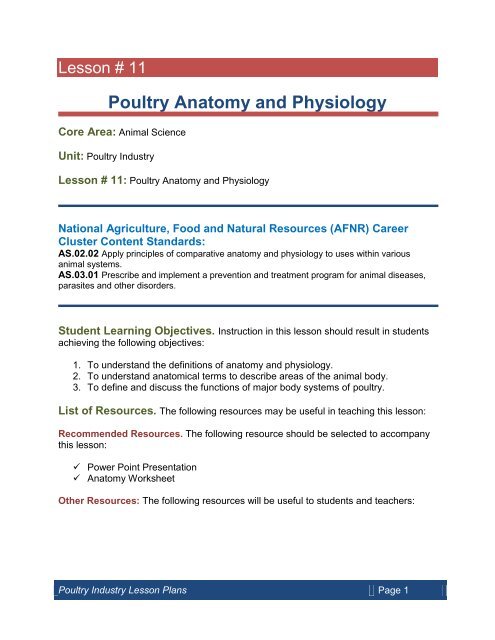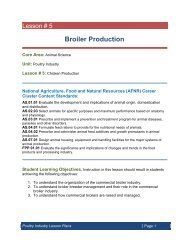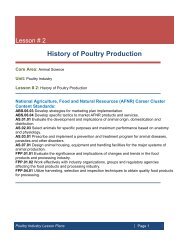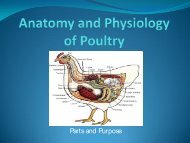Lesson Plan - U.S. Poultry and Egg Association
Lesson Plan - U.S. Poultry and Egg Association
Lesson Plan - U.S. Poultry and Egg Association
Create successful ePaper yourself
Turn your PDF publications into a flip-book with our unique Google optimized e-Paper software.
<strong>Lesson</strong> # 11<br />
<strong>Poultry</strong> Anatomy <strong>and</strong> Physiology<br />
Core Area: Animal Science<br />
Unit: <strong>Poultry</strong> Industry<br />
<strong>Lesson</strong> # 11: <strong>Poultry</strong> Anatomy <strong>and</strong> Physiology<br />
National Agriculture, Food <strong>and</strong> Natural Resources (AFNR) Career<br />
Cluster Content St<strong>and</strong>ards:<br />
AS.02.02 Apply principles of comparative anatomy <strong>and</strong> physiology to uses within various<br />
animal systems.<br />
AS.03.01 Prescribe <strong>and</strong> implement a prevention <strong>and</strong> treatment program for animal diseases,<br />
parasites <strong>and</strong> other disorders.<br />
Student Learning Objectives. Instruction in this lesson should result in students<br />
achieving the following objectives:<br />
1. To underst<strong>and</strong> the definitions of anatomy <strong>and</strong> physiology.<br />
2. To underst<strong>and</strong> anatomical terms to describe areas of the animal body.<br />
3. To define <strong>and</strong> discuss the functions of major body systems of poultry.<br />
List of Resources. The following resources may be useful in teaching this lesson:<br />
Recommended Resources. The following resource should be selected to accompany<br />
this lesson:<br />
Power Point Presentation<br />
Anatomy Worksheet<br />
Other Resources: The following resources will be useful to students <strong>and</strong> teachers:<br />
<strong>Poultry</strong> Industry <strong>Lesson</strong> <strong>Plan</strong>s Page 1
List of Equipment, Tools, Supplies, <strong>and</strong> Facilities.<br />
Lab Option 1: Dissection<br />
Scalpel<br />
Scissors<br />
Pins<br />
One euthanized chicken, preferably fully intact.<br />
Lab Option 2: Dissection Video<br />
Terms. The following terms are presented in this lesson (shown in bold italics):<br />
‣ Bronchi<br />
‣ Wattle<br />
‣ Comb<br />
‣ Larynx<br />
‣ Pneumatic Bones<br />
‣ Plumage<br />
‣ Filoplumes<br />
‣ Inhalation<br />
‣ Exhalation<br />
‣ Air Sacs<br />
‣ Nares<br />
‣ Uric Acid<br />
‣ Medullary<br />
‣ Shank<br />
‣ Ductus Deferens<br />
‣ Rudimentary Phallus<br />
‣ Vent<br />
‣ Deglutition<br />
‣ Crop<br />
‣ Proventriculus<br />
‣ Ceca<br />
‣ Cloaca<br />
‣ Bile<br />
‣ Erythrocyte<br />
‣ Gizzard<br />
‣ Leukocyte<br />
Interest Approach.<br />
With the guidance from the instructor have students list <strong>and</strong> discuss anatomical<br />
differences between birds <strong>and</strong> mammals. Have the students explain how these<br />
differences relate to unique physiological processes of birds.<br />
<strong>Poultry</strong> Industry <strong>Lesson</strong> <strong>Plan</strong>s Page 2
SUMMARY OF CONTENT AND<br />
TEACHING STRATEGIES<br />
Objective 1: Define Anatomy <strong>and</strong> Physiology.<br />
Anticipated Problem: What is the difference between the location of an organ <strong>and</strong> its<br />
actual purpose<br />
I. Anatomy<br />
A. Anatomy is the science of the structure of animals. The word is derived from<br />
the Greek work “to cut up.”<br />
II. Physiology<br />
A. Physiology is the science that deals with the functions of the living organism<br />
<strong>and</strong> its parts.<br />
III. Anatomical Terms<br />
A. The following terms are used to describe locations on the animal body.<br />
1. Dorsal: pertains to the upper surface of the animal.<br />
2. Ventral: relates to the lower <strong>and</strong> abdominal surface.<br />
3. Cranial (or anterior): applies to the front or head.<br />
4. Caudal (or posterior): pertains to the tail or rear.<br />
Teacher notes: A h<strong>and</strong>out is provided at the end of the lesson plan. Have students<br />
complete the h<strong>and</strong>out as you lecture about these terms.<br />
Objective 2: To underst<strong>and</strong> the anatomy <strong>and</strong> physiology of various avian<br />
systems <strong>and</strong> to underst<strong>and</strong> how they might differ from mammals.<br />
Anticipated Problem: How does avian anatomy <strong>and</strong> physiology differ from mammals<br />
I. Integumentary System<br />
A. The skin, or integumentary system, of poultry is similar to mammals, except<br />
for feather production. They have a wattle, defined as the red skin<br />
underneath the beak, <strong>and</strong> a comb, defined as the red skin located on top of<br />
their head. Blood circulates between the wattle <strong>and</strong> comb <strong>and</strong> helps to<br />
regulate body temperature.<br />
<strong>Poultry</strong> Industry <strong>Lesson</strong> <strong>Plan</strong>s Page 3
B. <strong>Poultry</strong> have plumage <strong>and</strong> beaks.<br />
1. Plumage is defined as the outer covering of a bird’s body. This<br />
includes feathers, scales, <strong>and</strong> filoplumes, which are hair-like<br />
structures located at the base of feathers. Scales are located on the<br />
legs <strong>and</strong> feet. The plumage allows for altered shape to facilitate<br />
necessary body cooling <strong>and</strong> heating for maintenance of body<br />
temperature. Plumage shape is particularly important for cooling since<br />
birds lack sweat gl<strong>and</strong>s. Although it is not common for production birds<br />
to fly, plumage type <strong>and</strong> form is an important determinant in flight for<br />
aerial species. Plumage protects against abrasions <strong>and</strong> bruises when<br />
birds are in groups or lying on the ground.<br />
2. Birds have beaks as opposed to lips <strong>and</strong> teeth. The beak is used for<br />
eating <strong>and</strong> drinking, as well as in self-defense <strong>and</strong> protection from<br />
other animals.<br />
II. Respiratory System<br />
A. The respiratory system of poultry is vastly different than the mammalian<br />
respiratory system. Unlike mammals, birds lack a diaphragm to inflate <strong>and</strong><br />
deflate the lungs. Instead, birds have nine air sacs located in the neck region<br />
<strong>and</strong> body cavity that function to inflate the lungs.<br />
1. Gas exchange occurs in the Avian lung <strong>and</strong> the air sacs function to<br />
move air in <strong>and</strong> out of the respiratory system.<br />
B. The breathing process has two phases: inhalation <strong>and</strong> exhalation.<br />
1. Inhalation: when the bird breathes in, air bypasses the lungs <strong>and</strong><br />
enters the posterior air sacs. At the same time, air in the lungs from the<br />
last exhalation phase exits the lungs <strong>and</strong> enters the anterior air sacs.<br />
2. Exhalation: the bird releases air from the posterior air sacs, which<br />
enters the lungs. The air that filled the anterior air sacs from the<br />
inhalation phase is then released from the body through the trachea.<br />
C. Nares are the nostrils located on the beak. Their purpose is the passageway<br />
for air to be breathed in <strong>and</strong> out of the trachea.<br />
III. Skeletal System of <strong>Poultry</strong><br />
A. Pneumatic Bones<br />
1. <strong>Poultry</strong> have pneumatic, hollow bones. These bones connect with the<br />
respiratory system <strong>and</strong> their light weight is an adaptation for flight.<br />
B. Medullary Bone<br />
1. Medullary bone contains high amounts of calcium <strong>and</strong> this storage<br />
source is used by the female hen when developing the egg shell during<br />
reproductive periods.<br />
C. Fused Bones<br />
1. Bones in the foot, or shank, are fused <strong>and</strong> cause birds to walk upright.<br />
2. Many vertebrate along the backbone are fused for the purpose of flight.<br />
<strong>Poultry</strong> Industry <strong>Lesson</strong> <strong>Plan</strong>s Page 4
IV. Digestive System:<br />
A. The purpose of the poultry digestive system is to use nutrients found in feed<br />
through the processes of digestion <strong>and</strong> absorption.<br />
B. The digestive system begins at the oral cavity <strong>and</strong> ends at the vent.<br />
1. Oral cavity<br />
a. Tongue: the tongue functions to move food within the oral cavity<br />
<strong>and</strong> initiates deglutition, or swallowing, of feed.<br />
2. Esophagus<br />
a. The esophagus is a flexible tube that carries food from the oral<br />
cavity to the crop <strong>and</strong> proventriculus.<br />
3. Crop<br />
a. The crop is an outcropping, or pouch, of the esophagus.<br />
b. The crop functions to store feed. No digestion of food takes place in<br />
the crop.<br />
4. Proventriculus<br />
a. The proventriculus is the true stomach of the bird, similar to the<br />
mammalian stomach.<br />
b. The proventriculus uses acid <strong>and</strong> other digestive enzymes to begin<br />
the chemical breakdown of food.<br />
5. Gizzard<br />
a. The gizzard is also called the ventriculus.<br />
b. The gizzard contains well-developed musculature <strong>and</strong> functions by<br />
grinding <strong>and</strong> contacting to aid in the mechanical reduction of food<br />
particles.<br />
c. The gizzard may contain small pebbles or gravel from foraging to<br />
aid in the reduction of food particle size.<br />
6. Small Intestine<br />
a. After passing the gizzard <strong>and</strong> being reduced to the proper particle<br />
size, food enters the small intestine for further digestion <strong>and</strong><br />
absorption.<br />
b. There are three regions of the small intestine:<br />
1. Duodenum<br />
2. Jejunum<br />
3. Ileum<br />
c. The small intestine has a very large absorptive area due to many<br />
folds <strong>and</strong> finger-like projections located along its length.<br />
7. Ceca<br />
a. <strong>Poultry</strong> have two ceca, while mammals have one (appendix).<br />
b. The ceca are two dead-end pouches that contain microbes.<br />
c. The microbes ferment any left over food particles <strong>and</strong> produce<br />
molecules that the bird can use as an energy source.<br />
8. Colon<br />
a. Also referred to as the large intestine.<br />
b. This a short section of the digestive tract that starts after the ceca<br />
<strong>and</strong> ends at the cloaca.<br />
c. The function of the colon is to absorb water.<br />
<strong>Poultry</strong> Industry <strong>Lesson</strong> <strong>Plan</strong>s Page 5
9. Cloaca<br />
a. This is also known as the vestibule <strong>and</strong> is the chamber responsible<br />
for the expulsion of feces <strong>and</strong> urine.<br />
10. Liver<br />
a. The liver is an accessory organ of the digestive system.<br />
b. The liver produces a substance called bile, which helps to digest<br />
fats. Bile is stored in the gall bladder.<br />
11. Pancreas<br />
a. The pancreas is an accessory organ of the digestive system.<br />
b. This is a yellow organ located in the loop of the duodenum.<br />
c. The pancreas produces digestive enzymes that are released into<br />
the small intestine to help digest protein <strong>and</strong> carbohydrate.<br />
d. The pancreas produces the hormones insulin <strong>and</strong> glucagon, which<br />
work together to control blood-sugar level.<br />
V. Circulatory System<br />
A. The purpose of the circulatory system is to control the flow of blood<br />
throughout the body.<br />
B. There many organs of the circulatory system:<br />
1. Heart<br />
a. A large organ that is located in the chest cavity.<br />
b. The poultry heart has four chambers: two atrium <strong>and</strong> two ventricles.<br />
c. The heart pumps blood throughout the body to deliver oxygen <strong>and</strong><br />
nutrients to tissues <strong>and</strong> to remove carbon dioxide <strong>and</strong> metabolic<br />
waste from tissues.<br />
2. Blood Vessels<br />
a. Arteries – deliver blood from the heart to tissues.<br />
b. Arterioles – smaller branches of arteries that direct blood to certain<br />
tissues.<br />
c. Capillaries – site of gas, nutrient, <strong>and</strong> waste exchange between the<br />
blood <strong>and</strong> the body’s tissues.<br />
d. Veins – deliver blood from the tissues to the heart <strong>and</strong> lungs for<br />
oxygenation.<br />
3. Blood<br />
a. Composed of plasma <strong>and</strong> blood cells.<br />
1. Avian red blood cells, also known as erythrocytes, are<br />
nucleated, unlike non-nucleated mammalian red blood cells.<br />
They are produced in the bone marrow <strong>and</strong> transport<br />
oxygen.<br />
2. White blood cells, or leukocytes, are important in fighting<br />
disease in the body. They are cells of the immune system.<br />
3. Plasma makes up the majority of the blood. It contains many<br />
different molecules, such as water, glucose, plasma<br />
proteins, <strong>and</strong> plasma enzymes.<br />
<strong>Poultry</strong> Industry <strong>Lesson</strong> <strong>Plan</strong>s Page 6
VI. Urinary System<br />
A. Kidneys – two multi-lobular structures located in the rib cage.<br />
1. The kidneys produce urine by removing waste products from the blood.<br />
B. Ureters<br />
1. Transport kidney filtrate from the kidneys to the cloaca for excretion.<br />
2. Birds do not have a bladder, so urine is not stored, but rather excreted<br />
into the cloaca when produced.<br />
C. Cloaca<br />
1. Feces <strong>and</strong> urine exit out of the bird’s body through this region in the<br />
abdominal cavity.<br />
D. Uric Acid Excretion<br />
1. <strong>Poultry</strong> excreta contain uric acid. Uric acid is very high in nitrogen <strong>and</strong><br />
is semi-solid due to low water content.<br />
VII. Reproductive System<br />
A. Male Reproductive Tract<br />
1. Two testes located internally in the body.<br />
2. Ductus Deferens<br />
a. Deliver semen from the testes to the phallus.<br />
3. Rudimentary phallus<br />
a. <strong>Poultry</strong> have no external penis, but rather a protuberance termed a<br />
rudimentary phallus.<br />
B. Female Reproductive Tract<br />
1. Ovary<br />
a. <strong>Poultry</strong> have only one functioning ovary, usually the left ovary.<br />
2. Oviduct<br />
a. Function<br />
1. To produce albumen (egg white), shell membrane, <strong>and</strong> the<br />
shell around the yolk.<br />
b. Five regions<br />
1. Infundibulum – receives the follicle <strong>and</strong> is the location of<br />
conception where the male <strong>and</strong> female gamete come<br />
together.<br />
2. Magnum – produces the albumen.<br />
3. Isthmus – produces the inner <strong>and</strong> outer shell membranes.<br />
4. Uterus – plumps the egg, forms the shell <strong>and</strong> cuticle (seals<br />
pores of the egg shell) <strong>and</strong> determines the shell pigment.<br />
5. Vagina – produces some cuticle, <strong>and</strong> expels the egg <strong>and</strong><br />
regulates timing of egg production.<br />
3. Cloaca – Also known as the vestibule. The cloaca is the common<br />
chamber through which the egg passes <strong>and</strong> is also responsible for the<br />
expulsion of feces <strong>and</strong> urine.<br />
4. Vent – the exterior opening through which passage occurs from the<br />
digestive system, the urinary tract <strong>and</strong> the reproductive tract.<br />
<strong>Poultry</strong> Industry <strong>Lesson</strong> <strong>Plan</strong>s Page 7
5. Ovulation -the releasing of the egg yolk from the ovary to begin its<br />
journey through the oviduct.<br />
6. Oviposition -the process of laying the fully formed egg which is<br />
regulated by hormones.<br />
Teacher notes: Have students fill in h<strong>and</strong>out as you lecture. Assign Worksheet:<br />
Anatomy of the Avian System. More information on the female reproductive tract is<br />
available in the “<strong>Egg</strong> Laying Hens” lesson plan.<br />
Review/Summary. Focus the review of the lesson around the student learning<br />
objectives. Ask students to explain the content associated with each objective. Use their<br />
responses as the basis for determining any areas that need to be covered again.<br />
Application. Application can involve student activity with the provided labs.<br />
Evaluation. Evaluation should focus on student achievement of the objectives for the<br />
lesson. Various techniques can be used, such as a written test. A sample test is<br />
attached.<br />
Answers to Sample Test:<br />
Part One: Terms<br />
Integumentary<br />
System<br />
Respiratory<br />
System<br />
Skeletal<br />
System<br />
Digestive<br />
System<br />
Circulatory<br />
System<br />
Urinary<br />
System<br />
Reproductive<br />
System<br />
Wattle Inhalation Pneumatic<br />
bones<br />
Deglutition Erythrocyte Uric acid Ductus<br />
defrens<br />
Comb Exhalation Medullary Crop Leukocyte Cloaca Rudimentary<br />
phallus<br />
Plumage Air sacs Shank Proventriculus Cloaca<br />
Filoplumes Nares Ceca<br />
Gizzard<br />
Cloaca<br />
Part Two: T / F<br />
1. T 6. T 11. F 16. T<br />
2. T 7. T 12. T<br />
3. F 8. F 13. T<br />
4. T 9. T 14. F<br />
5. T 10. T 15. T<br />
<strong>Poultry</strong> Industry <strong>Lesson</strong> <strong>Plan</strong>s Page 8








